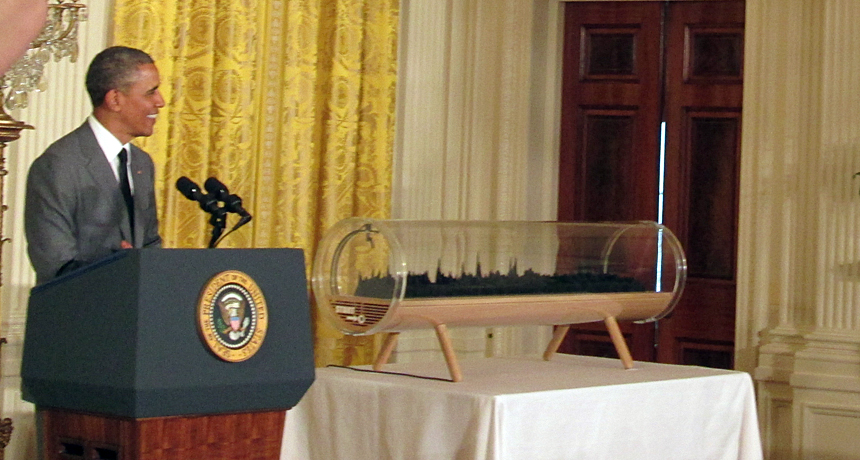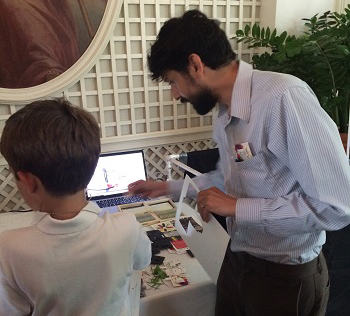Inventors give the White House a Maker-over
The first White House Maker Faire draws inventors of all ages

President Barack Obama addresses the first White House Maker Faire, next to a 3-D printed representation of his 2014 State of the Union Address.
B. Brookshire/SSP
WASHINGTON, D.C. — “I have to ask: What on Earth have you done to my house?” A smiling President Barack Obama was referring to the White House, which on June 18 hosted its first Maker Faire. “There’s a robotic giraffe. There’s a giant red weather balloon in the Rose Garden. There’s a paper-crafted dinosaur head in the hallway. Over here is a 3-D-printed sculpture of my State of the Union Address!” The president stood next to a series of spikes representing the voiceprint of his speech. Clearly, the president concluded, “this is not your typical day at the White House.”
The event was a celebration of all things maker, from robots big and small to a 3-D printer that “printed” pancakes. The president held the fair to draw attention to the type of hands-on building and learning that might help strengthen the United States’ economy in the future.

Manu Prakash is an inventor from Stanford University and the winner of the Science, Play and Research Kit Competition, or SPARK. He showed fair-goers at the White House how to build a microscope out of folded paper. He hopes his inventions will provide scientists with cheaper alternatives to their now very pricey lab equipment.
But you don’t have to be a university scientist to get started in the maker movement. The Beatty sisters — Camille, 14, and Genevieve, 12 — are running Beatty Robotics. Both attend Carolina Day School in Asheville, N.C. They began their youthful careers by taking things apart to find out what was inside. Soon, the sisters were making parts and building robots. They now have more than 30 robots on display in museums around the world, including a model of the Mars Curiosity Rover in the New York Hall of Science.
But the show stopper at the Maker Faire was large in both size and personality. Named Russell, the full-sized mechanical giraffe chewed, swayed, walked and even talked. Lindsay Lawlor, a computer scientist from San Diego, Calif., created this orange robot to bring art and science together. He has beautiful light displays and music to go with his lifelike movements.
Russell Pinnington is a computer programmer. He helped construct the mechanical beast. He says Russell, which Lawlor named after him, is actually modeled after a small toy: the Tamiya mechanical giraffe. Many inventions displayed at the White House were designed as science projects or to solve problems. But Russell arrived at the Maker Faire for another reason entirely. “What’s he for?” That’s simple, Pinnington said: “He just makes people smile.”
Follow Eureka! Lab on Twitter
Power Words
chemistry The field of science that deals with the composition, structure and properties of substances and how they interact with one another. Chemists use this knowledge to study unfamiliar substances, to reproduce large quantities of useful substances or to design and create new and useful substances.
computer program A set of instructions that a computer uses to perform some analysis or computation. The writing of these instructions is known as computer programming.
computer science The scientific study of the principles and use of computers.
model A simulation of a real-world event (usually using a computer) that has been developed to predict one or more likely outcomes.
robot A machine that can sense its environment, process information and respond with specific actions. Some robots can act without any human input, while others are guided by a human.